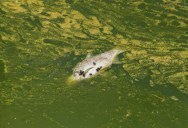This Catastrophic Chain Of Events Was The Likely Cause Of A Mass Extinction

If you think the world has been extra interested lately in what might have caused previous mass extinction events, you’re probably right.
Because maybe if we understand the cause of those, we can at least try not to make the same mistakes again.
This long and catastrophic chain of events occurred during the Mesozoic era, when oxygen levels were so low it caused multiple mass extinctions of marine life.
Recent research suggests that plate tectonics could have played a large role, as this was the same period in which the supercontinent Gondwana broke up.

This team looked for evidence that the pulses of phosphorus that were released during this time could be linked to declining oxygen levels (also known as ocean anoxic events, or OAEs) in the oceans.
Much of this phosphorus came from volcanic rock like basalt, both on the continents and on the seafloor.
Using a computer model called an Earth system model to simulate potential effects of the phosphorus pulses on the string of OAEs, and found that it recreated the process almost exactly.
Phosphorus is an essential element for life, but as with just about everything in this world, you can have too much of a good thing.

The pulses of additional phosphorus led to more growth of marine organisms as well as upped their productivity. This led to more organic matter on the ocean floor, and as it decomposed it used oxygen on a large scale.
Study co-author Professor Benjamin Mills says the effects were disastrous for other life.
“This process eventually caused swathes of oceans to become anoxic, or oxygen-depleted, creating ‘dead zones’ where most marine life perished.”
Professor Tom Gernon, another lead author on the study, goes even further.
“These OAEs were like hitting the reset button on the planet’s ecosystems. Tearing continents apart can have profound repercussions for the course of evolution.”

Today’s oceans have also seen a drop in oxygen, and the researchers are hoping their data could help us figure out a way to manage it before more marine life goes extinct.
“It’s remarkable how a chain of events within the Earth can impact the surface, often with devastating effects. Studying geological events offers valuable insights that can help us grasp how the Earth may respond to future climatic and environmental stresses.”
It’s crazy sometimes to think about how different our world has looked since it first came into being.
And how different it will likely look again in the future, whether we’re around to witness those changes or not.
If you thought that was interesting, you might like to read a story that reveals Earth’s priciest precious metal isn’t gold or platinum and costs over $10,000 an ounce!

Sign up to get our BEST stories of the week straight to your inbox.




